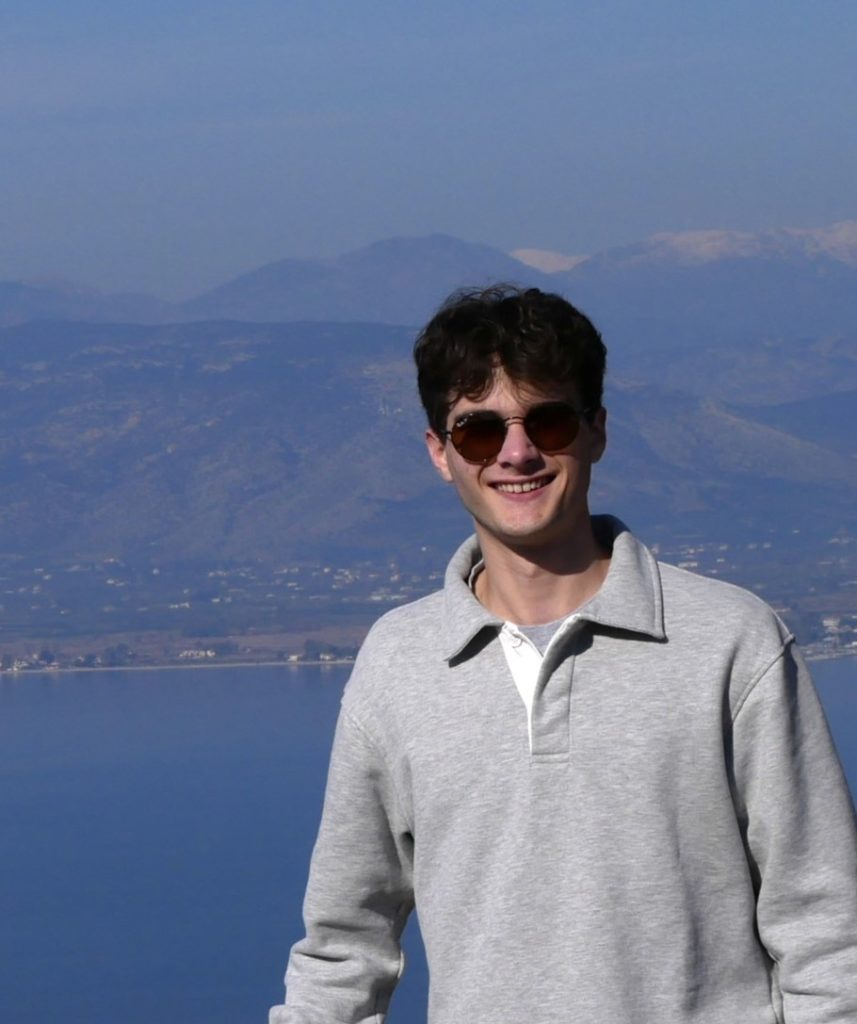
Courtesy of The Basil & Elise Goulandris Foundation
Introduction
In our present age, there is an increasing amount of hubbub surrounding the advancement of certain technologies. More specifically, increased attention in our current zeitgeist has been given to Artificial Intelligence (A.I.). A.I. has been a part of popular culture since the 20th century.[1] Before recent years, the acronym A.I. prompted one to imagine works of science fiction like Stanley Kubrik’s 2001: A Space Odyssey or Isaac Asimov’s I, Robot. Needless to say, the A.I. that is ubiquitous at present is not an obstinate ship computer, nor a psychological robot. Neither has A.I. taken the form of ridiculous robots such as Marvin the paranoid android from The Hitchhiker’s Guide to the Galaxy or Bender from Futurama. As entertaining as these Artificial Intelligences may be in their respective works of fiction, they are just that: works of fiction. It is for that reason that I mention them now; they are irrelevant to the argument of this paper.[2] Rather, generative A.I., such as ChatGPT or other A.I. “tools” that have made their way into the world from Grammarly to Spotify, are not from worlds of fiction. These uses of A.I. may seem innocuous—beneficial even—but the same cannot be said from our professors, who know only to trust undergrads as far as they trust our excuses for skipping classes. One such professor would be very skeptical of these new “intelligences.” C.S. Lewis could not have predicted the technological advancements that have led us to this contemporary discussion, but he gets uncannily close in his Deep Heavens Trilogy.[3] What is evident, though, is that he rightly exposed the theological and philosophical underpinnings of such advancements.
It will become clear that in the final book of Lewis’ Deep Heavens Trilogy, That Hideous Strength, A.I. is only a manifestation of a thoroughly un-Christian philosophy of transhumanism. Here is a definition of the philosophical school: “Transhumanism is the movement aimed toward the use of technology for the human enhancement of social, psychological, and physical lives.”[4] Maybe this does not sound like it is a relevant idea for the discussion of chatbots and Spotify DJ’s with terrible music recommendations, but I assure you that it is. Sam Altman, the CEO of OpenAI (the company that invented ChatGPT), provides a voice for the transhumanism of the current age. It is clear how much Altman and the antagonists of Lewis’ novel have in common. By exposing this similarity, I will show how the implications of this twisted anthropology are in contradiction to the Christian view of creation and anthropology, and even to our conception of God.
A Summary of That Hideous Strength
Before analyzing some of the antagonists of That Hideous Strength, it is helpful to provide a summary of the overarching theme of the book, in addition to providing a character profile. That Hideous Strength takes place after the first two books in the trilogy, Out of the Silent Planet and Perelandra, though Lewis assures his readers that this final book “can be read on its own.”[5] That Hideous Strength tells the story of seemingly average newlyweds, Jane and Mark Studdock. Both spouses begin to experience frustration in their new marriage, partly due to Mark’s overly ambitious desire to be a part of the “inner ring” at the college where he is a fellow and partly due to Jane’s dissatisfaction with how she has come to imagine married life in regards to her academic ambitions. The rift between the couple causes two things: Mark is taken in by the seemingly “progressive” but actually sinister National Institute of Co-ordinated Experiments (N.I.C.E.), while Jane, beginning to have clairvoyant dreams concerning the malicious deeds of the N.I.C.E., is taken in by the benevolent cohort headed by the Pendragon of Logres, Dr. Elwin Ransom, the protagonist of the first two books in the Trilogy. I will call Ransom’s faction St. Anne’s. The antagonistic N.I.C.E. is described as such: “The N.I.C.E. was the first-fruits of that constructive fusion between the state and the laboratory on which so many thoughtful people base their hopes for a better world.”[6] Or so it seems. In reality, the organization, with its esoteric meritocracy and devilish tactics, is set on taking over Britain through sociological programs and a private police force. Behind the scenes, demons control the N.I.C.E. and communicate through their “Head.” There are only a few true initiates in the organization, and now Mark is one of their promising new followers. All the while, Jane is taken in by St. Anne’s, which is trying to thwart the N.I.C.E. with the help of angels, God’s creation, and a long-dormant wizard whom Jane helps to find.
Filostrato’s Transhumanist
Anthropology Professor Filostrato, a physiologist who is responsible for the “Head” of N.I.C.E. and one of the initiates in the organization, is the first antagonist to consider. This “Head” interlocutor is literally a human head that Filostrato has managed to keep gruesomely animated. Why is Filostrato keeping this head alive? He reasons, “In [human beings,] organic life has produced Mind. It has done its work. After that we want no more of it…Slowly we learn how. Learn to make our brains live with less and less body.”[7] Filostrato’s project is to get rid of all organic material, all things natural, and, by virtue, creation as a whole. When we speak of creation, we mean the natural world—the world which God has created with all its processes and observable laws. God has created Life; he has created “Mind;” he has done so through natural processes. But Filostrato hopes to create “Life,” if one can call it that, without nature. This is textbook transhumanism, though not explicitly stated by Lewis.
Consider Filostrato’s goal in comparison to what Sam Altman says in his own blog. Of the advancement of A.I., he states, “We are already in the phase of co-evolution—the A.I.s affect, effect, and infect us, and then we improve the AI.”[8] Here, Altman is referring to what he calls “The Merge,” that is, the merge between human life and A.I. It is also worth noting that Altman wrote this in December of 2017, almost six years before the aforementioned hubbub around A.I. took place. Altman and Filostrato are talking about the same thing. What Altman is anticipating, or what he is certain is already happening, is a ‘merge’ between the natural and the artificial. Recall the definition of transhumanism: “Transhumanism is the movement aimed toward the use of technology for the human enhancement of social, psychological, and physical lives.” Filostrato and transhumanists would have it that the merge which Altman speaks of becomes a reality.
It is clear that Lewis believes this to be a bad thing, or else he would not have made Filostrato in league with his villainous troupe. So how does Filostrato’s transhumanism contradict Christian anthropology? The operative assumption here is that man is a creation of God, and thus part of the natural world. But not only this, for man is also distinct from nature: “Then God said, ‘Let us make humans in our image, according to our likeness, and let them have dominion [over the natural order].’”[9] God intends for us to care for nature, just as he cares for us; this is our commission as beings with a higher intellect.[10] However, there is a temptation borne out of the Fall of Man that Lewis terms in The Abolition of Man (the non-fiction counter-part of That Hideous Strength) as “Man’s conquest of Nature.”[11] Here is how he describes temptation through Filostrato’s mouth:
[The N.I.C.E.] is for the conquest of death: or for the conquest of organic life, if you prefer. They are the same thing. It is to bring out of that cocoon of organic life which sheltered the babyhood of mind the New Man, the man who will not die, the artificial man, free from Nature. Nature is the ladder we have climbed up by, now we kick her away.[12]
Instead of seeing nature as something that we, as humans, are meant to protect and use in a God-fearing way, posthuman transhumanism seeks to find a way to replace human beings with A.I.[13] But this ultimately denies nature her own fulfillment, for St. Paul tells us that,
For the creation waits with eager longing for the revealing of the children of God, for the creation was subjected to futility, not of its own will, but by the will of the one who subjected it, in hope that the creation itself will be set free from its enslavement to decay and will obtain the freedom of the glory of the children of God.[14]
In opposition to this, Filostrato seeks immortality through the advancement of technology in a purely unnatural way. But St. Paul assures us that our being set free from death is not humanly devised, nor is nature’s freedom from decay and entropy. Rather, it is through God that we find our immortality. The fallacy, according to Christianity, of transhumanism is this: man is not responsible or capable of his own transcendence.
Yet, this is the very notion that is being thrown around today concerning A.I. Altman himself believes that “unless we destroy ourselves first, superhuman AI is going to happen, genetic enhancement is going to happen, and brain-machine interfaces are going to happen.”[15] But this is precisely what Lewis imagines happening if these things are to come to fruition: it will be an abolition of man.
Straik’s Transhumanist Theology
Another important antagonist to consider is the Reverend Straik, a priest who is also one of the initiated N.I.C.E. members. Straik, however, is not pious. Rather, he is a transhumanist masquerading himself with Christian jargon. Given this inconsistency, Mark asks why Straik is in the organization by pointing out that Christians “look forward to something else, something better than human society, in some other world.”[16] To this Straik replies, “‘I repudiate that damnable doctrine…The Kingdom of God is to be realized here—in this world. And it will be.’”[17] At face value, this does not seem to be such a bad goal; isn’t it the hope of every Christian that the Kingdom of God would be realized in their space and time? Only, notice that Straik is not talking about a realization of the Kingdom as being now-and-not-yet. It is the “damnable doctrine” which Straik rejects that is Christian hope: that while Christians work for the Kingdom now, they know it will be realized in the consummation of all things, not fully in the here and now. Straik proposes that this hope is due to a misunderstanding of Jesus’ teaching (which, of course, only he understands), and that the only way to realize the Kingdom is through the transcendence of humankind. He says, “[The sciences] are an irresistible instrument… because they are the work of [God’s] hand. An instrument of judgment as well as of healing.”[18] Indeed, he goes so far as to tell Mark that “the real resurrection is even now taking place. The real life everlasting. Here in this world. You will see it.”[19]
It is true that this is a similar sentiment to what Sam Altman regards the “Merge,” maintaining that human transcendence, or our extinction, will happen soon. But there is another group of transhumanists which Lewis is exposing in our present age: the Christian Transhumanists. According to the Christian Transhumanist Association, Christians have an obligation to foster technological advancement for the betterment of humanity and creation. They also warn of the dangers that accompany A.I. It is necessary for Christians to enter this realm of discourse. It should go without saying that to alleviate suffering that impedes human flourishing is a Christian ideal and that Christians have a responsibility to support scientific research to alleviate such suffering. This does not discount the fact that Christian Transhumanists are mistaken to conflate the hope of Christianity with that of transhumanism, specifically as it relates to A.I. This is precisely what Straik does. For instance, here is one of their ‘Affirmations’: “We recognize science and technology as tangible expressions of our God-given impulse to explore and discover and as a natural outgrowth of being created in the image of God.”[20] This is too close to Straik’s exclamation that science is an “irresistible instrument.” What is underpinning Straik and the Christian Transhumanists’ affirmation of science is a Hegelian confusion of God’s actualization in the world. They believe, like Hegel that God is realized in humanity. Of Hegel’s philosophy of religion, Robert C. Solomon says, “Immortality, heaven and hell, are reduced to nothing more than the survival of the human spirit in others after our individual deaths.”[21] No longer does Christianity contain hope for the Christian Transhumanist, but it contains a rejection of Christ’s sufficiency to alleviate suffering; instead, their Christianity is reliant upon innovation to carry on humanity. For if Christianity is merely the survival of the belief in God passed down through humans, then of course science must be supported to ensure the longevity of the human race ad infinitum. “‘It is the beginning of Man Immortal and Man Ubiquitous,’ said Straik [to Mark]. ‘Man on the throne of the universe.’”[22]
This premise of Transhumanism demonstrates a clear misunderstanding of man’s relation to God. For it is not God who is dependent on Man but the other way around. Man’s humanity is only fully realized insofar as he is participating in the divine. This may sound nonsensical but is only the converse of the Incarnation. The Greek Orthodox writer and translator Philip Sherrard puts it eloquently,
There is a cooperation of the divine and the human, the uncreated and the created. Christ is the perfect man, the complete man, the whole man. But Christ is also God. This is to say that, paradox as it may sound, it is God alone who is the perfect man. Only God is completely and utterly human.[23]
But the transhumanist version of this would be that only humanity is completely and utterly human. There is a perverse incarnation implicit here that suggests that man can transcend into the divine of himself.
Conclusion
If we accept that Straik and Filostrato’s theology and anthropology are true, we also assume that humanity is totally distinct from both God and His creation. In the end of That Hideous Strength, though, Lewis makes it clear that this is far from the case. The book ends in hope realized. More specifically, it ends in consummation; it ends in the consummation of nature, of man, ultimately through and towards God.
Transhumanism presented in Lewis’ novel is not all too unsimilar from that which is observed in present “advancements” in A.I. and other transhumanist movements, implicit or explicit. As Christians, we ought to consider how the church and daily Christian practices will be affected by these changes. Can a chatbot help a Christian to pray? Can A.I. help to console grieving parents when their child has died suddenly and terribly? The answer is unequivocally no. But these ‘conquests’ of Man over Nature are already occurring.[24] Lewis has laid this conundrum out clearly in That Hideous Strength, and, almost a century later, the evil machinations that he wrote of in his work of fiction are coming to realization. It is the responsibility of the church and, in particular, the Christian academy to resist these dehumanizing innovations.

Aidan Charron ’24 is majoring in Christian History and Theology, and Philosophy and minoring in Classics. He is from Pittsburgh, Pennsylvania. He would like to thank Dr. Madison Pierce and the Great Lakes Theology Conference (Western Theological Seminary), Dr. Jared Ortiz (Religion), and Dr. Jeff Tyler (Religion) for their help and encouragementwith this piece.
Footnotes
[1] An argument could be made that Mary Shelley first peaked our interest in A.I.
[2] The only one of these references to A.I. to keep in mind would be Asimov’s Three Laws, as they relate directly to the ethical considerations of A.I., but they will not figure into this paper.
[3] Thanks should be given to Dr. Jared Ortiz for correcting me from calling it by its popular “Space Trilogy” name.
[4] Carlos Mariscal, “Life”, The Stanford Encyclopedia of Philosophy (Winter 2021 Edition), ed. Edward N. Zalta, .
[5] Lewis, Clive S. That Hideous Strength. New York, NY: Scribner, 2003, 8.
[6] Lewis, That Hideous Strength, 21.
[7] Ibid. 170.
[8] Sam Altman. “The Merge.” Web log. Posthaven (blog), December 2017, https://blog.samaltman.com/the-merge.
[9] Gen. 1:26.
[10] C.S. Lewis, The Abolition of Man. New York (NY: Macmillan, 1955), 69.
[11] Ibid, 71.
[12] Lewis, That Hideous Strength.174.
[13] Mariscal, “Life.”
[14] Rom 8:19-21.
[15] Altman, “The Merge.”
[16] Lewis, That Hideous Strength, 76.
[17] Ibid, 76-77.
[18] Ibid, 77.
[19] Ibid, 78.
[20] “Christian Transhumanist Affirmation.” Christian Transhumanist Association: Faith, Technology, and the Future. Accessed 2023. https://www.christiantranshumanism.org/affirmation/.
[21] Robert C. Solomon, “The Secret of Hegel (Kierkegaard’s Complaint): A Study in Hegel’s Philosophy of Religion,” From Hegel to Existentialism, (New York, NY: Oxford University Press, 1987), 61.
[22] Lewis, That Hideous Strength, 175.
[23] Philip Sherrard, The Rape of Man and Nature: An Enquiry into the Origins and Consequences of Modern Science, (Limni, Evia: Denise Harvey, 2015), 21.
[24] Kirsten Grieshaber, “Can a Chatbot Preach a Good Sermon? Hundreds Attend Church Service Generated by CHATGPT to Find Out,” AP News, June 12, 2023, https://apnews.com/article/germany-church-protestants-chatgpt-ai-sermon-651f21c24cfb47e312 e987a7263d348.


